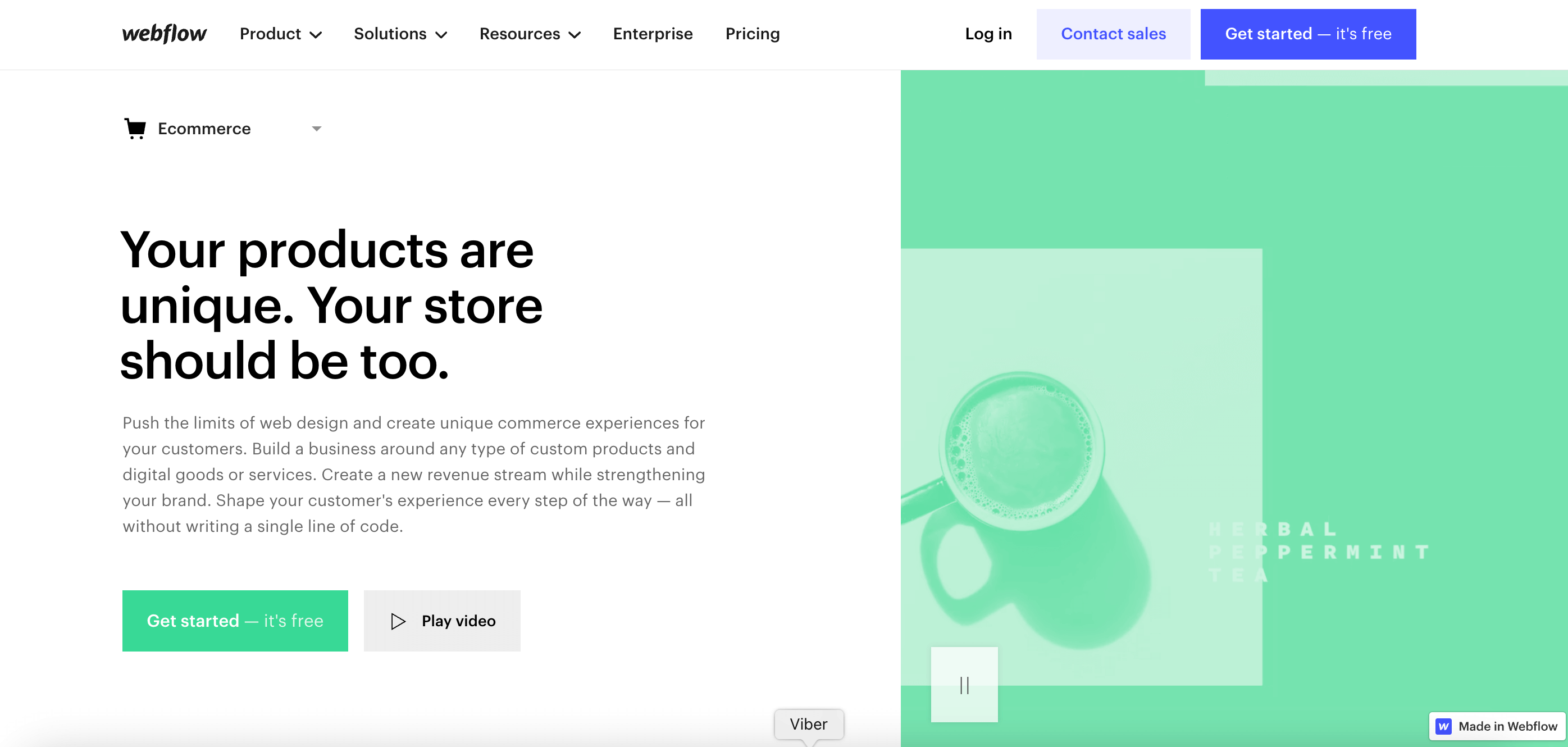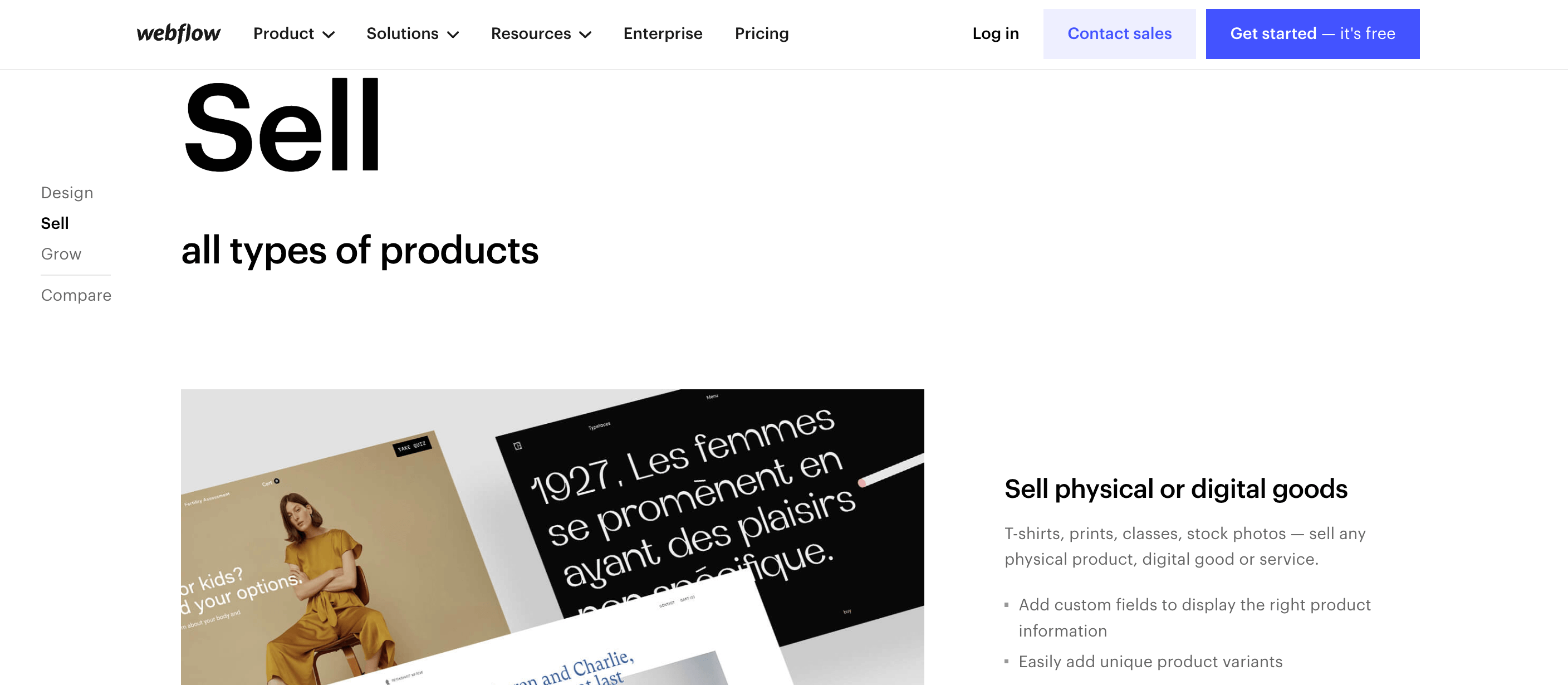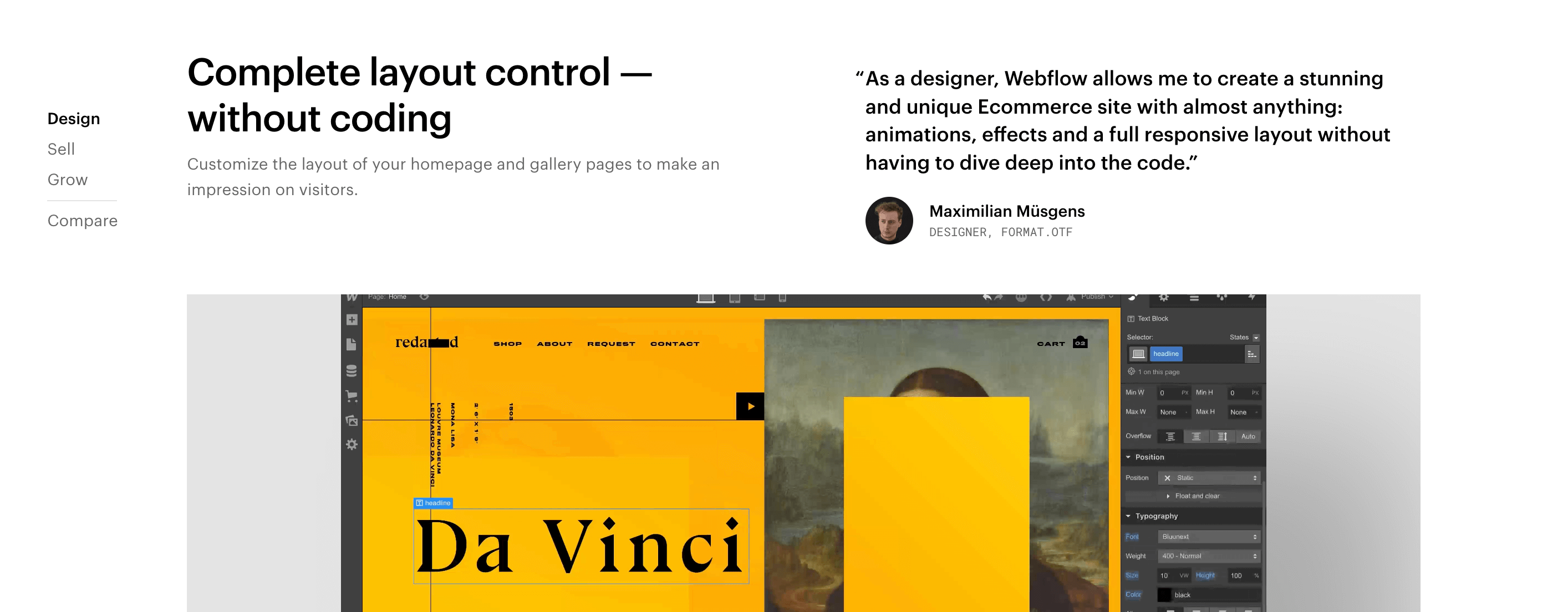Webflow vs Shopify 2023: Unveiling the Pros and Cons of Each E-commerce Giant
 September 05, 2023
September 05, 2023 In the ever-expanding world of e-commerce, business owners have a plethora of choices when it comes to selecting the right platform for their online store. Two popular options are Webflow vs Shopify. Both platforms offer powerful features and capabilities, but they also have distinct advantages and disadvantages. In this article, we will delve into the pros and cons of each e-commerce giant, providing you with the necessary information to make an informed decision for your online business.
Pros and Cons of Webflow for E-commerce
Webflow is a versatile website builder that has gained popularity among e-commerce entrepreneurs. One of the major advantages of Webflow is its intuitive drag-and-drop interface, which allows users to easily create and customize their online stores without any coding knowledge. This platform also offers a wide range of responsive templates and design options, giving you the creative freedom to build a visually stunning website.
Another key benefit of Webflow is its built-in content management system (CMS), which enables you to easily manage and update your product inventory, blog posts, and other website content. This streamlined approach saves you time and effort, allowing you to focus on growing your online business. However, it's worth noting that Webflow's CMS is not as robust as Shopify's, which might be a drawback for businesses with large product catalogs.
On the downside, Webflow's e-commerce functionality is relatively new and still evolving. While it offers essential features such as secure payment processing and inventory management, it may lack some of the advanced tools and integrations that Shopify provides. Additionally, Webflow's pricing structure might not be suitable for businesses on a tight budget, as it can be more expensive compared to other e-commerce platforms.
Pros of using Webflow for E-commerce:
- Design Flexibility: Webflow provides a visually intuitive interface for designing your website. You have complete control over the design, which is great for creating a unique and appealing e-commerce site.
- No Coding Required: Webflow is designed for designers and developers alike, but you don't need extensive coding knowledge to build an e-commerce site. This can save time and resources.
- Customizable Templates: Webflow offers a variety of templates that you can customize to fit your e-commerce needs. This can be a time-saver if you're not starting from scratch.
- Responsive Design: Webflow allows you to create responsive, mobile-friendly websites easily, which is crucial for e-commerce, as many customers shop from mobile devices.
- Content Management: It offers a robust content management system (CMS), making it easy to manage products, categories, and other e-commerce content.
- SEO-Friendly: Webflow provides features for optimizing your site for search engines, which is essential for e-commerce success.
- Web Hosting Included: Webflow includes web hosting in its plans, so you don't have to worry about finding a separate hosting provider.
Cons of using Webflow for E-commerce:
- Limited E-commerce Features: Webflow's e-commerce functionality is not as comprehensive as specialized e-commerce platforms like Shopify or WooCommerce. It may lack advanced features such as multi-channel selling, extensive payment gateway options, or complex inventory management.
- Learning Curve: While Webflow is designed to be user-friendly, it still has a learning curve, especially for those who are new to web design or e-commerce.
- Cost: Depending on your needs, Webflow can be more expensive than some other e-commerce platforms. While it offers free and lower-tier plans, advanced e-commerce features come with higher subscription costs.
- Third-Party Integrations: Webflow has limited third-party integrations compared to platforms like Shopify, which has a vast app ecosystem. This could be a limitation if you need to connect with specific tools or services.
- Scalability: For very large e-commerce operations, Webflow might not be the best choice due to potential scalability issues and limitations.
- Support: While Webflow has a support system, it might not be as extensive or specialized as the support offered by e-commerce-focused platforms.
In summary, Webflow is a viable option for smaller to mid-sized e-commerce businesses that prioritize design flexibility and are comfortable with a learning curve. However, for larger e-commerce operations with complex needs, you may find specialized e-commerce platforms like Shopify or Magento to be more suitable due to their advanced features and scalability. Your choice should ultimately depend on your specific business requirements and your willingness to work within the constraints of Webflow's e-commerce capabilities.
Pros and Cons of Shopify for E-commerce
Shopify, on the other hand, is a well-established and widely-used e-commerce platform that has powered millions of online stores. One of the main advantages of Shopify is its user-friendly interface and ease of use. Setting up your online store with Shopify is a breeze, thanks to its intuitive dashboard and comprehensive step-by-step guides. This makes it an ideal choice for beginners and non-technical users.
Another strength of Shopify is its extensive app store, which provides a wide array of plugins and integrations to enhance your store's functionality. Whether you need advanced inventory management, marketing tools, or customer support features, you can find a suitable app on the Shopify marketplace. Additionally, Shopify offers powerful SEO features to help you optimize your online store and improve its visibility in search engine results.
However, one potential drawback of Shopify is its transaction fees. While Shopify provides a range of pricing plans, some of the lower-tier plans charge additional transaction fees for each sale made on your store. This can eat into your profit margins, especially if you have a high volume of sales. Additionally, customizing your store's design can be more challenging compared to Webflow, as Shopify uses a proprietary Liquid programming language.
Shopify vs webflow ecommerce
Pros of using Shopify for E-commerce:
- User-Friendly: Shopify is renowned for its user-friendly interface, making it accessible to beginners with little to no technical knowledge. Setting up and managing an online store is relatively straightforward.
- Quick Setup: You can launch a basic e-commerce store in a matter of hours with Shopify, thanks to its intuitive setup process and a wide range of pre-designed templates.
- Customizable Design: Shopify offers a variety of customizable themes, and you can further modify them to fit your brand and design preferences. You can also use the Shopify Theme Editor to make changes without coding.
- App Store: Shopify has a vast app store with numerous add-ons and integrations, allowing you to extend your store's functionality with features like email marketing, inventory management, and more.
- Secure and Reliable: Shopify takes care of security, hosting, and software updates, ensuring your site is secure and always up-to-date. This is particularly important for e-commerce websites that handle sensitive customer information.
- Mobile-Responsive: All Shopify themes are mobile-responsive, ensuring that your e-commerce site looks and functions well on mobile devices, which is crucial for reaching a broader audience.
- Scalability: Shopify can accommodate the needs of small businesses and scale up to support larger enterprises, making it suitable for businesses of various sizes.
- Payment Gateway Options: Shopify provides numerous payment gateway options, and it also has its own payment solution (Shopify Payments) for seamless transactions.
- 24/7 Customer Support: Shopify offers 24/7 customer support via email, live chat, and phone, providing assistance whenever you need it.
Cons of using Shopify for E-commerce:
- Monthly Costs: While Shopify offers various pricing plans, it can become expensive as your business grows, especially when you start adding apps and integrations.
- Transaction Fees: Shopify charges transaction fees on every sale if you don't use their payment gateway (Shopify Payments), which can add up over time.
- Limited Free Themes: Although Shopify provides free themes, many of the premium-quality themes are paid, which can increase your initial setup costs
- Platform Lock-in: While Shopify is highly customizable, some businesses may feel locked into the platform due to the reliance on its infrastructure and proprietary features.
- Advanced Customization: While Shopify is beginner-friendly, extensive customizations may require knowledge of Liquid, its templating language, or hiring a developer.
- Inventory Management: Some users have reported limitations in handling large inventories with complex product variants.
- SEO: While Shopify is SEO-friendly, advanced SEO customization may require third-party apps or coding expertise.
In summary, Shopify is an excellent choice for many e-commerce businesses, especially those looking for an easy-to-use platform with a wide range of features and scalability. However, it's essential to consider the costs associated with Shopify, including transaction fees and app expenses, as well as the platform's long-term suitability for your business's growth and customization needs. Evaluate your specific requirements and budget to determine if Shopify is the right fit for your e-commerce venture.
Webflow vs Shopify: A Detailed Comparison
Now that we have explored the pros and cons of Webflow and Shopify individually, let's compare these two e-commerce giants side by side. When it comes to design flexibility, Webflow takes the lead with its powerful visual editor and extensive customization options. With Webflow, you have complete control over your website's layout, typography, and animations. On the other hand, Shopify offers a range of professionally designed templates that are optimized for conversions. If you prioritize ease of use and a quick setup, Shopify might be the better choice for you.
In terms of e-commerce features, Shopify outshines Webflow with its comprehensive suite of tools. Shopify offers advanced inventory management, order tracking, abandoned cart recovery, and more. It also seamlessly integrates with popular payment gateways, making it easy for customers to make purchases on your store. While Webflow has made significant improvements to its e-commerce functionality, it still falls short in terms of the breadth and depth of features offered by Shopify.
When it comes to pricing, Webflow and Shopify have different approaches. Webflow offers a tiered pricing structure based on the number of projects and features you need. This can be advantageous if you have a small store or a limited budget. On the other hand, Shopify offers three main pricing plans with varying levels of features and support. While Shopify's plans may be more expensive, they provide robust customer support and additional features that can help your business thrive.
Webflow to Shopify: Transferring Your Project
If you currently have a Webflow store and are considering switching to Shopify, you may be wondering how to transfer your project. Fortunately, there are several methods available to smoothly migrate your website and product data from Webflow to Shopify. One option is to manually export your product information from Webflow and import it into Shopify using CSV files. This can be a time-consuming process, especially if you have a large product catalog.
Alternatively, you can seek the assistance of e-commerce experts, such as Mgroup, to handle the migration process for you. With their expertise and knowledge of both Webflow and Shopify, they can ensure a seamless transition of your store, minimizing any potential downtime or data loss. Contact Mgroup today to transfer your Webflow store to Shopify and benefit from their eCommerce expertise.
Webflow vs WordPress for E-commerce
While Webflow and Shopify are often compared, another popular e-commerce platform worth considering is WordPress. WordPress is a powerful content management system (CMS) that can be extended with e-commerce plugins such as WooCommerce. Compared to Webflow, WordPress offers a wider range of themes and plugins, making it a versatile choice for businesses with unique requirements. However, WordPress requires more technical knowledge to set up and maintain, which might be a barrier for non-technical users.
Webflow vs Squarespace for E-commerce
Squarespace is another website builder that offers e-commerce functionality. Similar to Webflow, Squarespace provides an intuitive drag-and-drop interface and visually appealing templates. However, when it comes to e-commerce features and flexibility, Webflow has the upper hand. Squarespace may be suitable for small-scale stores or businesses that prioritize simplicity, but for larger e-commerce operations, Webflow offers more advanced capabilities.
Webflow Shopify Integration: Setting Up Your Online Store
If you have decided that Shopify is the right platform for your e-commerce business, setting up your online store is a straightforward process. After signing up for a Shopify account, you can choose a theme from the Shopify theme store or upload a custom design. From there, you can configure your store's settings, add products, set up payment gateways, and customize your store's appearance. Shopify provides comprehensive documentation and support resources to guide you through the setup process.
Webflow vs Shopify: Which Platform is Best for Your E-commerce Business?
Ultimately, the choice between Webflow and Shopify depends on your specific business needs and priorities. If you value design flexibility and creative control, Webflow might be the better option. However, if you prioritize e-commerce features, ease of use, and a robust app ecosystem, Shopify is a strong contender. Consider factors such as your budget, technical expertise, and long-term growth plans when making your decision.
Conclusion: Making an Informed Decision Between Webflow and Shopify
In conclusion, both Webflow and Shopify are powerful e-commerce platforms that offer unique advantages and disadvantages. Webflow excels in design flexibility and intuitive website building, while Shopify shines in terms of e-commerce features and ease of use. By carefully considering the pros and cons of each platform and evaluating your business requirements, you can make an informed decision that sets you up for e-commerce success.
Making an informed decision between Webflow and Shopify depends on your specific needs, skills, and priorities for your e-commerce business. While both platforms have their merits, Shopify is often considered a better choice for many e-commerce businesses due to several key reasons:
- E-commerce Focus: Shopify is purpose-built for e-commerce, whereas Webflow is a general web design and development platform that offers e-commerce capabilities as an add-on. Shopify's primary focus on e-commerce means it has a comprehensive set of features specifically designed to support online selling, including robust inventory management, product variations, and order processing.
- App Ecosystem: Shopify has a vast and diverse app store with thousands of apps and integrations that can extend your store's functionality. These apps cover a wide range of needs, from marketing and SEO to shipping and analytics. Webflow's app ecosystem is comparatively limited in scope and size.
- Payment Processing: Shopify provides its own payment gateway, Shopify Payments, which offers competitive rates and seamless integration with your store. Webflow supports third-party payment gateways, but Shopify Payments simplifies the payment process for users.
- Security and Reliability: Shopify takes care of hosting, security, and software updates, ensuring that your store remains secure and operates reliably. Webflow offers hosting but may not be as robust in terms of e-commerce security and reliability.
- Ease of Use: Shopify is known for its user-friendly interface, making it accessible to users with varying levels of technical expertise. Webflow, while powerful, may have a steeper learning curve, especially if you're new to web design and development.
- Templates and Themes: Shopify offers a wide range of professionally designed e-commerce themes that are optimized for conversion. Webflow also provides templates, but Shopify's themes are specifically crafted for online stores and are more numerous and diverse.
- Customer Support: Shopify provides 24/7 customer support through various channels, including email, live chat, and phone. Webflow offers support but may not have the same level of availability or specialization in e-commerce.
- Scalability: Shopify is suitable for businesses of all sizes, from small startups to large enterprises. It can grow with your business and handle increased traffic and sales volumes.
- SEO Tools: Shopify offers built-in SEO features and tools to help improve your store's visibility in search engines. While Webflow also has SEO capabilities, Shopify's SEO optimization is well-known in the industry.
- Brand Recognition: Shopify is a well-established and trusted platform in the e-commerce industry, which can instill confidence in customers and partners.
That said, Webflow does have its strengths, particularly in design flexibility and creative control. If you prioritize complete control over your website's design and have web design or development experience, Webflow might be a better fit. However, you may need to invest more time in mastering the platform and potentially integrating third-party e-commerce features.
In summary, Shopify is generally the better choice for most e-commerce businesses due to its specialized focus, extensive features, robust app ecosystem, and reliability. However, your final decision should align with your specific business goals, budget, and your level of comfort with web development and design. Consider your unique requirements and assess both platforms thoroughly before making a decision.
Remember, if you decide to transfer your Webflow store to Shopify, contact Mgroup to ensure a seamless migration and benefit from their eCommerce expertise.











